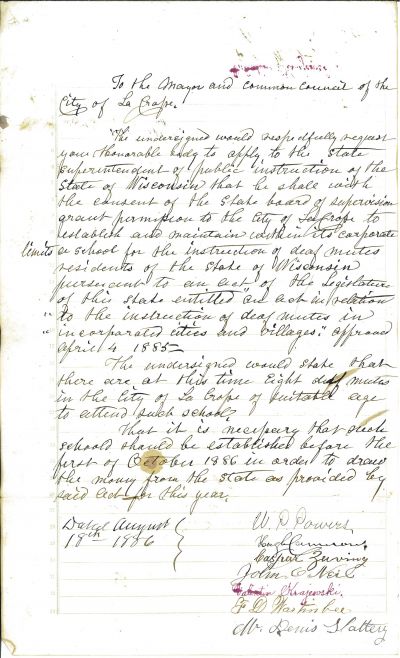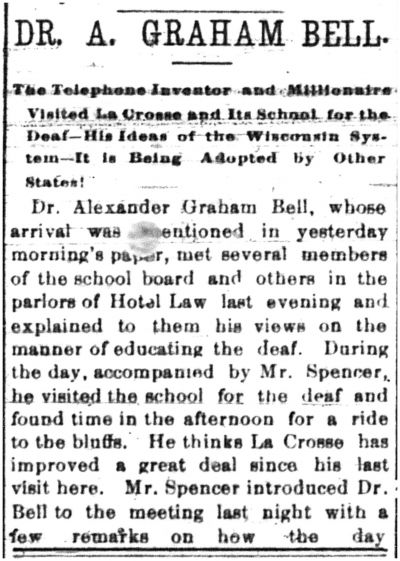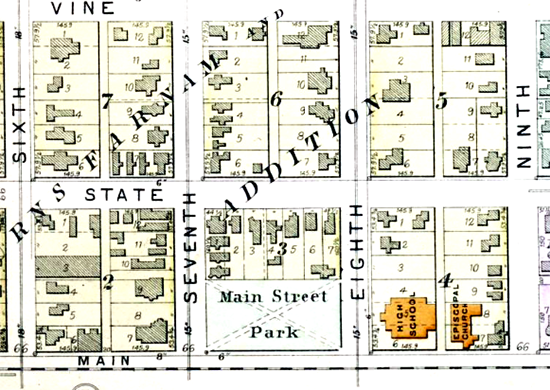
La Crosse School for the Deaf
(written by Meghan Hoefling, Archives staff)
On August 18, 1886, several citizens of La Crosse signed a petition to the mayor requesting the establishment of a school for the deaf in the city. The petition came just one year after a law was passed in the Wisconsin Legislature allowing for incorporated cities and villages to “establish and maintain, within its corporate limits, one or more schools for the instruction of deaf mutes…” (1885 Act 315)

Petition from La Crosse residents requesting a School for the Deaf. Dated August 18, 1896. La Crosse Series 027
Previously, children who were deaf had to travel to the Wisconsin School for the Deaf in Delavan, Wisconsin to receive an education. That school opened in 1852 and was residential, meaning students had to leave their homes and families to attend. The opening of ‘day schools,’—such as the school established in La Crosse—around the state meant that education was available to more children with hearing impairments. However, there was also a darker motivation for opening day schools. In the 1880s, some educators of the deaf were embracing a practice called oralism. Oralism was an approach that discouraged the use of sign language, instead teaching lip-reading and speaking. The oralism movement was endorsed by well-known inventor Alexander Graham Bell, who argued that the use of sign language discouraged people who were deaf from assimilating into hearing culture. He also argued that people who were deaf tended to marry other deaf people, increasing the occurrence of hereditary deafness. The use of oralism in schools was meant to combat this, instead it resulted in a significant loss for deaf culture.

27 March 1896 La Crosse Chronicle
In the 1880s, Alexander Graham Bell advocated to state legislatures for the establishment of day schools, and Wisconsin was the first state to buy into the idea. This was likely the push for the 1885 passage of Chapter 315 into Wisconsin’s State law, and the petition from La Crosse citizens in August of 1886 to establish a School for the Deaf. The mayor and common council approved the petition just two days later, and immediately applied for approval from the state. The first school for the deaf in La Crosse was organized and opened in January of 1887. Bell traveled to La Crosse twice to visit the La Crosse School for the Deaf. In March of 1896, a headline in the La Crosse Chronicle read, “Prof. Bell in Town. But Don’t Apply to Him to Mend Your Telephone—He Has Other Business.”
The first school for children with hearing impairments was located on the corner of Division and Seventh streets. A class of two or three students was taught by Rella Parker in a residence there. During its first few months the school continued to grow, with five regular students by April 1887. In the fall of 1887, Viola Taylor took over the school. Over the next decade, the school moved quarters regularly to accommodate its growing student body. Viola Taylor ran the school until 1891, when her sister, Minnie Taylor Trousdale took over. Unfortunately, Minnie departed in 1896, and the school was temporarily discontinued.

Ca. 1899. Teachers Margaret Maywool and Vie Pennell with students at the School for the Deaf, located at the corner of Logan and Liberty Streets.
The La Crosse School for the Deaf reopened in 1899 as an oral school, meaning that students were taught without the use of sign language. This was approved by the state in November of 1899. At the beginning of the school year the school had six students enrolled and by the summer of 1900, there were twelve. In 1901, the school also brought on another teacher. The school continued to operate out of various buildings on the northside of La Crosse until 1907, when the school moved to a building on 6th and Vine and then to the high school on the corner of Main and 8th Streets. At the time, this was La Crosse High School, but in 1907, a new high school was built on Cass Street on what is now Weigent Park. The school on Main and 8th became Washburn School.

Location of the high school on Eighth and Main Streets. 1898 City Atlas
La Crosse’s School for the Deaf remained the Washburn School for several decades, and La Crosse’s curriculum for students who were deaf or hard of hearing remained centered on oralism well into the 20th century. Students were still primarily learning to speak and read lips in 1956, when Washburn School became the first in the state to receive a ‘Chromalizer.’ This assistive technology converted sound into colored lights, and was designed to help students learn to speak.
Sign language was, and still is, a key component of deaf culture. While students may not have been allowed/encouraged to use sign language at school, there are signs that there was a thriving deaf culture in early 20th century La Crosse. The La Crosse Deaf Mute Association met monthly at the YMCA from 1897-1909, and in 1909 the Seven Star Club for Deaf Mutes began meeting in members’ homes. Another clue that La Crosse had a thriving deaf community is that in the summer of 1901, 100 delegates from the Wisconsin Deaf Mute Association hosted their 9th annual convention in La Crosse. In 1941 the convention was once again held in La Crosse, drawing 500 delegates.
2 July 1941 La Crosse Tribune (click image for full article)
The Washburn school closed in the 1970s, and was razed in 1984. At some point before the 1960s, students who were deaf or hard of hearing began to be integrated into junior and senior high school classes.

